Here you have a detailed Osprey Stratos vs Deuter Futura Packs comparison, it may help if you are undecided about these two impressive series. Keep reading.
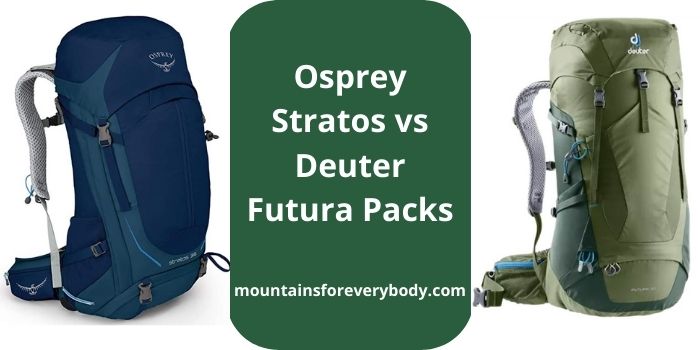
Why this Osprey Stratos vs Deuter Futura comparison
Both Deuter and Osprey are the leading manufacturers of backpacks and they are globally known. Of course, Deuter is much older, they have been around since the 19th century.
From a personal perspective, I own packs from both series and I am able to share some first-hand experience about these packs. Note that both series include many packs in various sizes, and there are important differences between smaller and bigger packs in each of the two series. For example, as of the moment of writing this text, there are at least 17 packs in the Deuter Futura series.
This is why it would be necessary to compare small and large packs separately or compare two specific packs from the two series. This is particularly important for the Deuter Futura series because larger packs have the word Vario in the name, and they also have Futura Pro sub-series. The word Vario indicates an adjustable torso size which you do not have in their smaller packs.
In the Osprey Stratos series there are also big differences between the small and large packs. So the comparison here is quite general, but I shall try to point out such details and differences within each of the two series so that you get some general idea about both of them. These are impressive series and you will realize from the features presented here why I decided to compare them.
Common features
Here are a few of the most important common features:
The tensioned trampoline-style ventilated back panel
This is a feature introduced by Deuter decades ago in this same Futura series. I started using it in 2003 in my first Deuter’s pack, the Futura 38. They do not build this pack any longer, but this does not mean that the pack is obsolete, it looks intact after so many years and you can see it here in the site in many of my climbs.
I am not sure how this works with patents and designs, but if Deuter had a patent, perhaps it expired after several decades, let me know if you know more. In any case, nowadays many top brands have such a trampoline style mesh in their new series. Below you can see how it looks in Osprey Stratos 24 and Deuter Futura 28 SL:
So if you have issues with ventilation, there is no better design. In this construction air can circulate in all directions, and the pack is completely separated from the body.
This also implies that the back of the pack is curved, and this takes some volume of the main compartment. Some even claim that this is not so great for the balance because the pack’s center of gravity/weight is a bit farther from the body. I do not think this is an issue at all.
Women’s specific designs
In the case of Deuter Futura packs, they have specific packs for women and they always have SL in the name. The letters mean ‘slim line’. So you can see this in their Deuter Futura Vario 45+10 SL Hiking Backpack For Women. The picture above shows the smaller pack Deuter Futura 28 SL.
However, in the case of Osprey’s packs, they have a separate name for women’s packs, and this is the Osprey Sirrus series. But this is practically the same as the Osprey Stratos series, and in the rest of the text I shall sometimes write Stratos/Sirus instead of Stratos.
So in both cases, there is no difference in functionality in those gender-specific versions. This is mainly about the differences in the body shapes and the packs are built to accommodate this.
Rain cover
Both series come with this bonus. You have a bottom zippered pocket where the rain cover is stored. You do not have to use it, and if so you can use the pocket for other purposes.
Multiple pockets
Both series Deuter Futura and Osprey Stratos/Sirrus are very functional and organization can hardly be better. If you check my text about Osprey Stratos 24 you will see that this small pack has 8 pockets in total.
Differences
Here are some that I find important:
Upper side zippered pockets
As mentioned above, both series have many pockets, but Deuter’s packs have some extras. You have upper bellows zippered pockets in many packs of the Futura series. This is a feature that I like, and in this respect, Futura Vario is better.
Torso adjustability system
In the case of larger packs from Deuter Futura you have what they call the VariSlide System based on a strap with some buckles, see the picture below. Osprey Stratos and Osprey Sirrus packs have Velcro based attachment. Both systems are continuous-type adjustment and by this I mean that you can have literally any torso length within a given range.
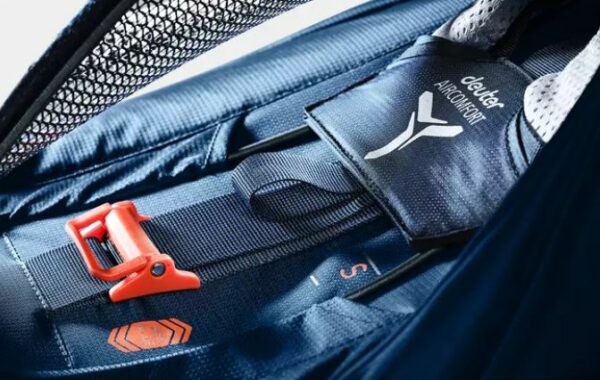
I like more the system of Deuter Futura packs, but note that this adjustability is only in their larger Vario packs. On the other hand, all packs from Osprey Stratos/Sirus series have an adjustable torso length. This makes Osprey packs better in general.
Additional volume
You have probably seen the numbers +10 in the names of some of the packs in the Deuter Futura series. So this is an expandable collar that adds an extra 10 liters of volume when you need it. This can be useful when you start your unsupported tour and you have more stuff in the pack, like extra food and water for example.
You may need such a feature in various other situations. For example, in the case of a cooler climate, you would carry thicker sleeping equipment and more clothes so you need more volume, while in summer you will need less volume, yet you can still use the same pack. This makes the Futura packs better. The picture below shows how this looks, observe that the lid is floating type to accommodate for such an extra volume:
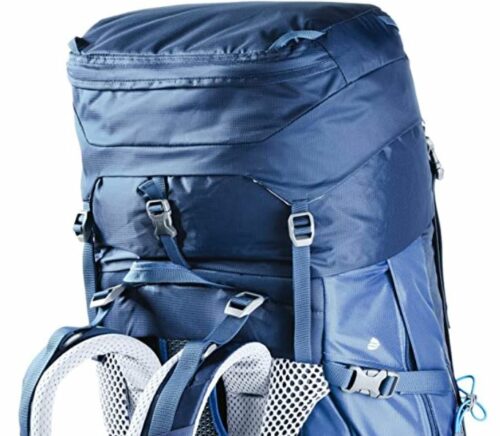
Poles attachment system
I think this part is easy, there is nothing that can be compared to Osprey’s Stove-on-the-Go poles attachment design. If you do not use trekking poles, this feature may be unimportant to you. But I always use trekking poles and I use this Osprey’s feature as well, so for me, Osprey is a clear winner here.
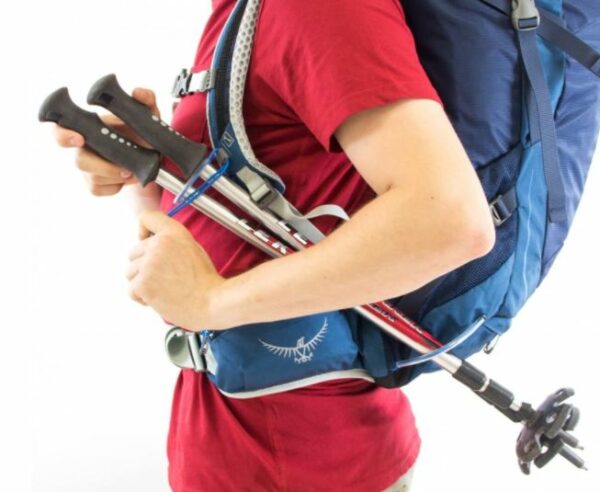
Access points
I think Deuter Futura is better here. There are several reasons for this. The largest packs in the series (the Vario packs) have top access, bottom compartment access, and also front U-shaped zippered access. Even very small packs in the series, like Deuter Futura 26, have this front access (but not the bottom access, you would not need it of course).
But note also that within the small packs in the Futura series you have two types, panel-loading packs and also packs with the lid and the top access. The first group has no other access point, and frankly, you do not need it in such small packs.
The fact is that they have made a mess with so different packs under the same name. For example, they have Deuter Futura 26 that is with the lid, while at the same time they have Deuter Futura 26 SL that is a totally different panel-loading type pack with a zippered entrance. This makes no much sense to me.
In the case of Osprey Stratos/Sirrus, the smaller packs are panel-loading type see my Osprey Stratos 24 as one example, and here you have only one access point. But their larger packs are top-loading with lid, plus a zippered bottom compartment access, plus a side zippered access.
With all this in mind, in this respect, I would give advantage to Deuter Futura packs. See how the front access in Deuter Futura Vario 50+10 pack looks:
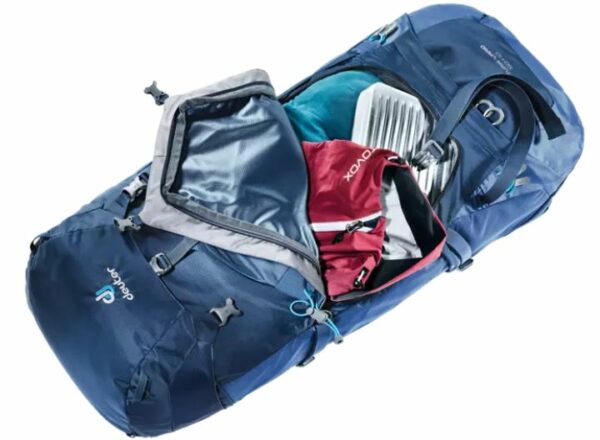
Hip belt design
It is not easy to find something better than the Deuter Futura hip belt system. These packs have massive padding and this makes the differences in the larger packs. For smaller packs, this is not so essential, but all in all, I find Deuter Futura packs better in this respect.
Volume/Weight ratio
Deuter packs are not the best when it comes to weight. However, there are very good reasons why their packs are a bit heavier than some of their competitors. I already mentioned extra zippered bellows pockets on the sides, so these zippers add weight.
There is also a zippered divider between the bottom compartment and the main compartment. So the two compartments are completely separated when this is necessary. Not many packs on the market can match this specific feature, but indeed this zipper adds weight. Observe also the massive padding on their hip belts, this adds weight but it also adds comfort.
But the fact is that the Sirus/Stratos packs are a bit better in this respect, so it is up to you, and you might want to take this as a fact. They could be described as moderately light, while Deuter Futura packs can be described as moderately heavy. In view of what I have said above, for me this is immaterial.
So which series is better?
You have seen my arguments and pros and cons regarding both series, and the table below summarizes what is expressed above. This is one possible summary, but if you would take some specific packs from the two series these results might be slightly different:
Ventilation
Gender designs
Rain cover
Pockets
Torso adjustability
Expandable volume
Pole attachment
Access points
Hip belt design
Volume/Weight ratio
Osprey Stratos/Sirrus
Deuter Futura
As you realize, the results are close to each other. So what would I choose? This depends on the size of the packs and on the purpose, this is how I see them.
- For larger packs, I would definitely go for the Deuter Futura Vario packs.
- For smaller packs, I would go for the Osprey Stratos. The main reasons for this are their adjustable torso length and their great Stove-on-the-Go attachment system.
- For the medium packs, this is a bit difficult for me to decide. The Osprey’s torso adjustability and the poles’ attachment remain as important factors, but Deuter’s side zippered bellows pockets and expandable volume are also very important. So I would decide dependent on the tour, and this is what I actually do in my mountaineering tours.
So this is how I see Osprey Stratos vs Deuter Futura packs. What do you think? It would be great to hear from you, so let me know, there is a comment box below. You might want also to read my comparison of Deuter Futura Vario vs Osprey Aether & Ariel packs.
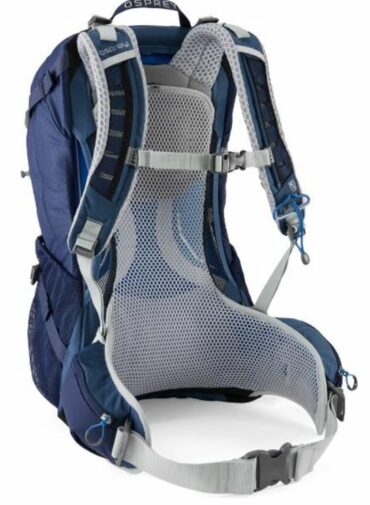
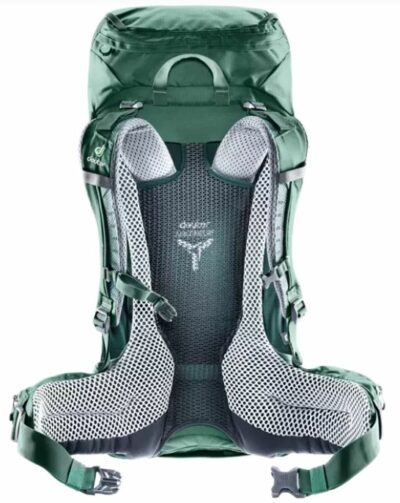
gianluca says
hi Jovo, thanks for the beautiful and useful contents!
I have one question about the ventilated back panel and comfort:
which one would you find more ventilated and comfortable between the deuter futura pro 36 (2022) and osprey exos 38 (2022)???
I sweat a lot and I’m looking for the more ventilated one without renouncing to comfort: the deuter seems more padded and comfortable (but less breathable?) while the osprey seems super ventilated and breathable (but less padded)…can you help me in this choice?
thanks
Jovo says
Thank you Gianluca. This latest Osprey pack version is a bit different from the previous. On the other hand in Deuter they have added those padding sections on the sides that reduce mesh area. So it looks that Osprey could be more breathable. Its torso length is also adjustable and this you do not have in Deuter Pro packs.
I am convinced that padding is better in the Deuter pack. If you have a chance to try them both in a local shop, this would be good to do. You will not get any idea about breathability of course, but it is important to know how the pack fits you.
John says
Greetings, Jovo. Thank you for all the reviews. I do wish you would include the date reviewed, in order to help discern how current a review is, but I do appreciate your comments. The practical, real life experience with the reviewed Items I find very helpful for evaluation.
This is an interesting article for me, as you have touched on the same things I have found to be important. Primary of which, is the ventilation and comfort of the trampoline style backpacks. My region is the Ohio valley area of the USA, where we have high humidity and fairly hot temperatures in the summer time. For reference, I am in my early 60’s, but fairly new to backpacking and trekking.
I have both an Osprey Atmos AG 65 (L) for backpacking, and a Deuter Futura 34 EL, which I use as a large daypack and for rucking. As I have a long (22″) torso, that took me up from the Futura 30 to the 34 EL.
There were three daypacks I had it narrowed down to – the Osprey Stratos 24, Futura 34 UL and the Gregory Zulu 30. I was able to try on the Stratos and Zulu at a local REI. No one had the Futura for me to try. Since I was looking to use it for exercise and training, weight was not a concern, but durability and ventilation were.
The Stratus felt great, but lacked a “shove it” front pocket and for some reason only comes with a white material for the parts in contact with the body. The Zulu also felt great and I had no concerns other than possibly, durability, as this was a new model and little data on which to rely.
What it largely came down to was your experience with the Futura line and the price. A great deal (over 50% off retail) presented itself in an outdated color (which I happened to like), so I ordered it, sight unseen. Turns out, it is great, for my purposes. Durability, ventilation and comfort are all outstanding. Usually I carry 25-30 pounds for anywhere from 3 – 12 miles at a time. The side water bottle pockets require some flexibility to use on the fly, but they work with 1 liter Smartwater bottles, just fine. One thing to note, the pack is tall with a narrow body, so the profile is small. I like that, because it does not interfere with my trekking pole use and allows for good manueverability in tight places.
For the primary backpack, the Atmos was the only choice for me, although the Zulu 55 and the Futura Vario 50+10 were contenders. I had previous experience with the Atmos and loved how it carried, so it was a known commodity. Price was less of an issue, but it turned out I got it as a gift, so it became a non-issue. It is a little on the heavier side than some options, however, I don’t through hike and don’t foresee backpacking for more than a week at a time. The comfort of the AG system is excellent, in my opinion and just carries so very well. Quality is excellent and of course there is the Osprey Almighty Guarantee, which I know you have discussed. The only thing I have against it is, for the price, it should include a raincover.
Jovo says
Hi John, your comment is the first thing I am reading this morning and I really enjoy it. It is great to read lines from somebody who is really using packs, I love them too and love to write about them.
The dates in the posts I removed just recently, it was a tough decision and this is for the reasons you mentioned already. I might enable them again, have to think about this. Your comment is a reminder. But in any case, this post is just a couple of months old.
I see you mention Osprey Atmos packs, they are still with the AG suspension, but it not clear what Osprey is going to do. They are replacing the AG system in many of their series, this happened most recently with their new 2021 versions of the Aether & Ariel series. I do not know if they are going to do the same with the Atmos & Aura packs. As you rightly say AG design is excellent and it is not clear to me why they are replacing it, at least in smaller and medium-sized packs.
You tried the best that is on the market regarding the tensioned trampoline style suspension and it is not surprising that you liked them all. I assume this was Futura 34 EL not UL. You are right about the missing rain cover in the Osprey packs, pity.